By 1910, J.C. had landed two advertising accounts that would set the shape of his career even more than magazine covers: Kuppenheimer Clothes and Arrow Collar.
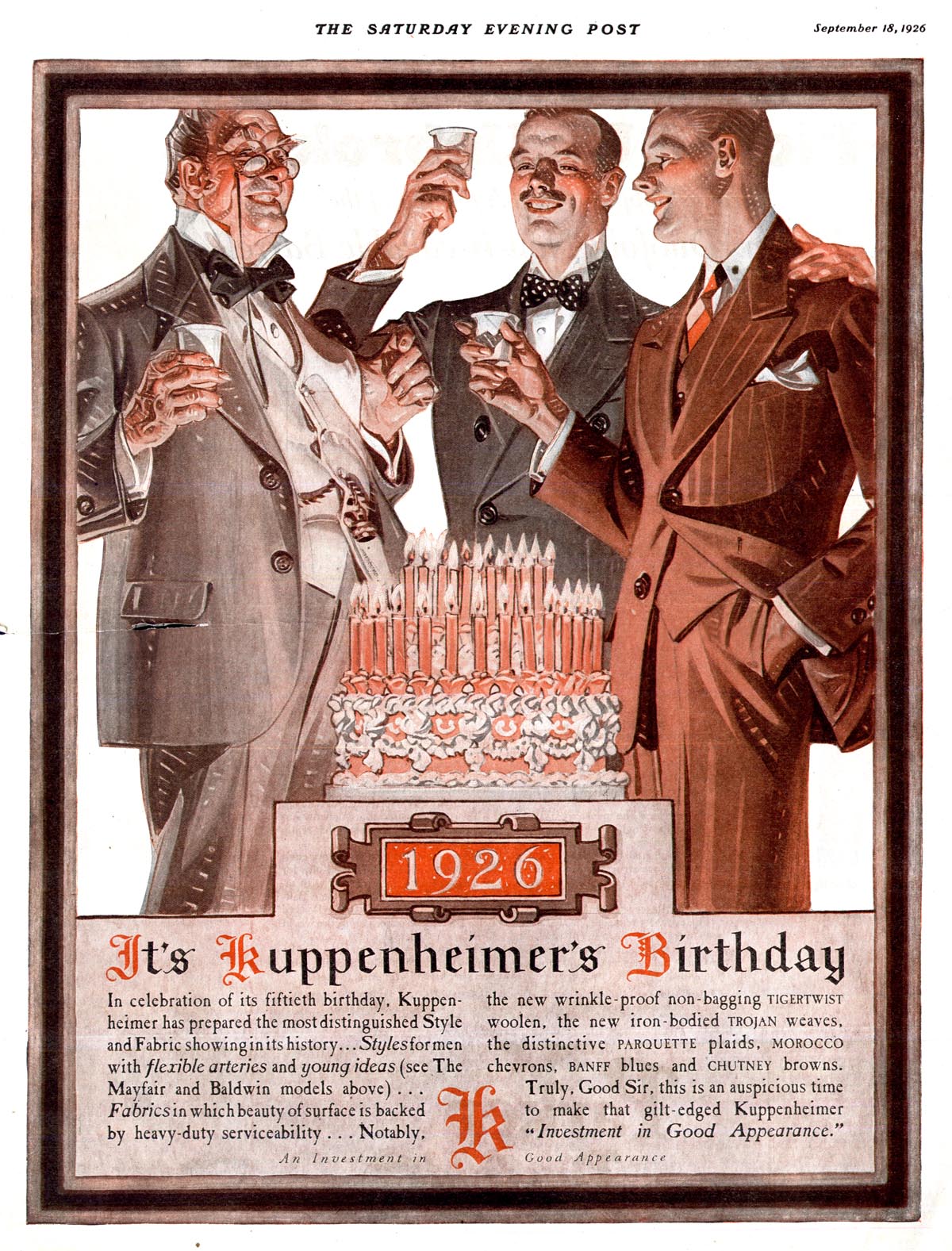
Couture was important to J.C., and he had been producing a stream of fashion advertising since 1898.
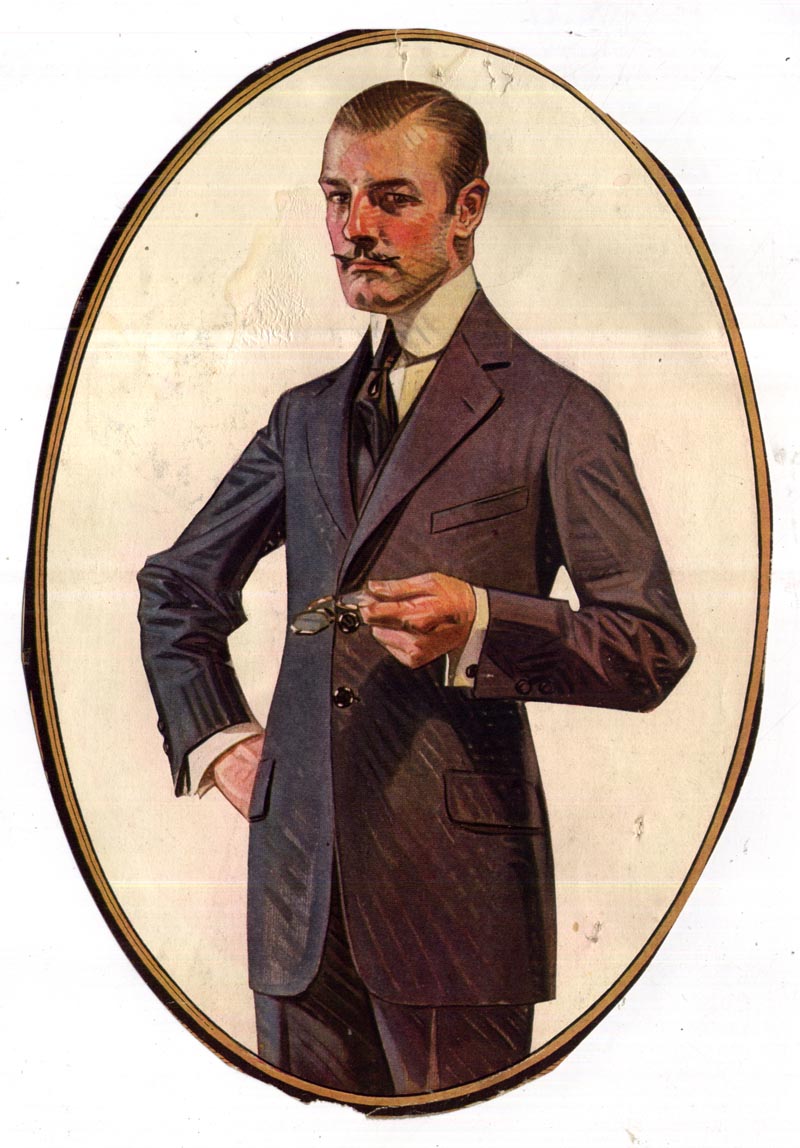
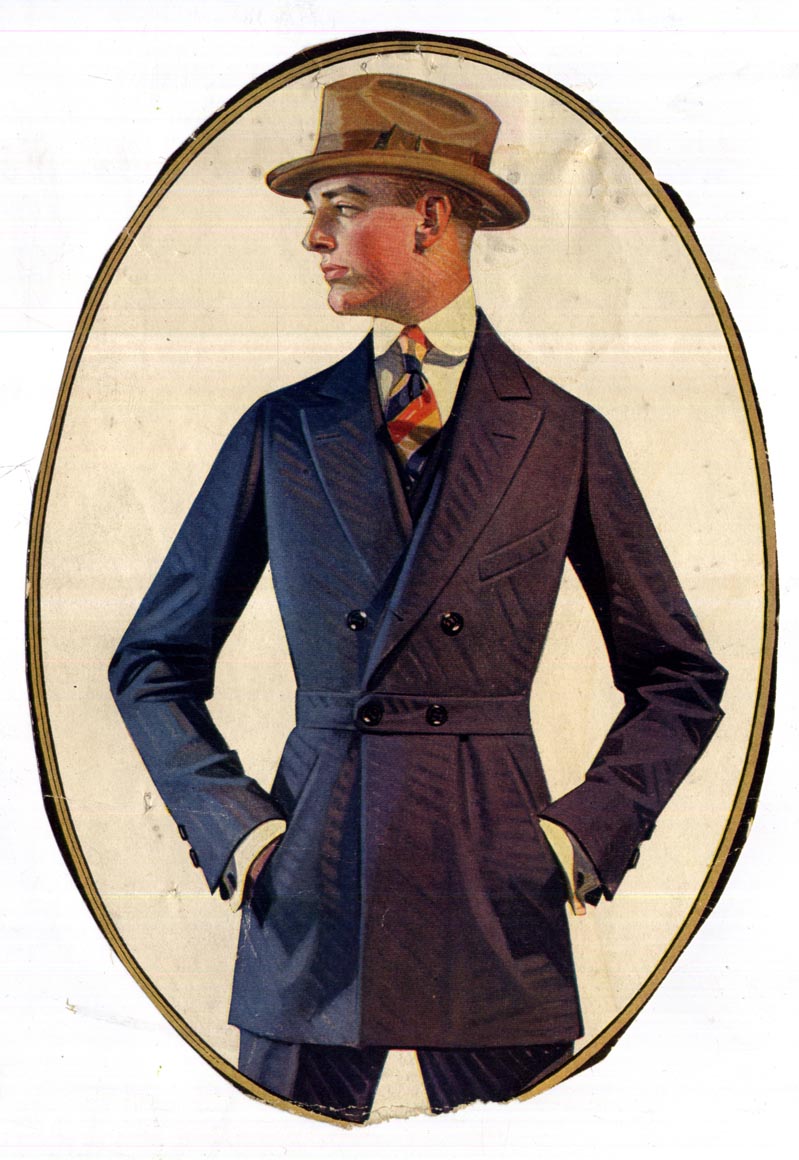
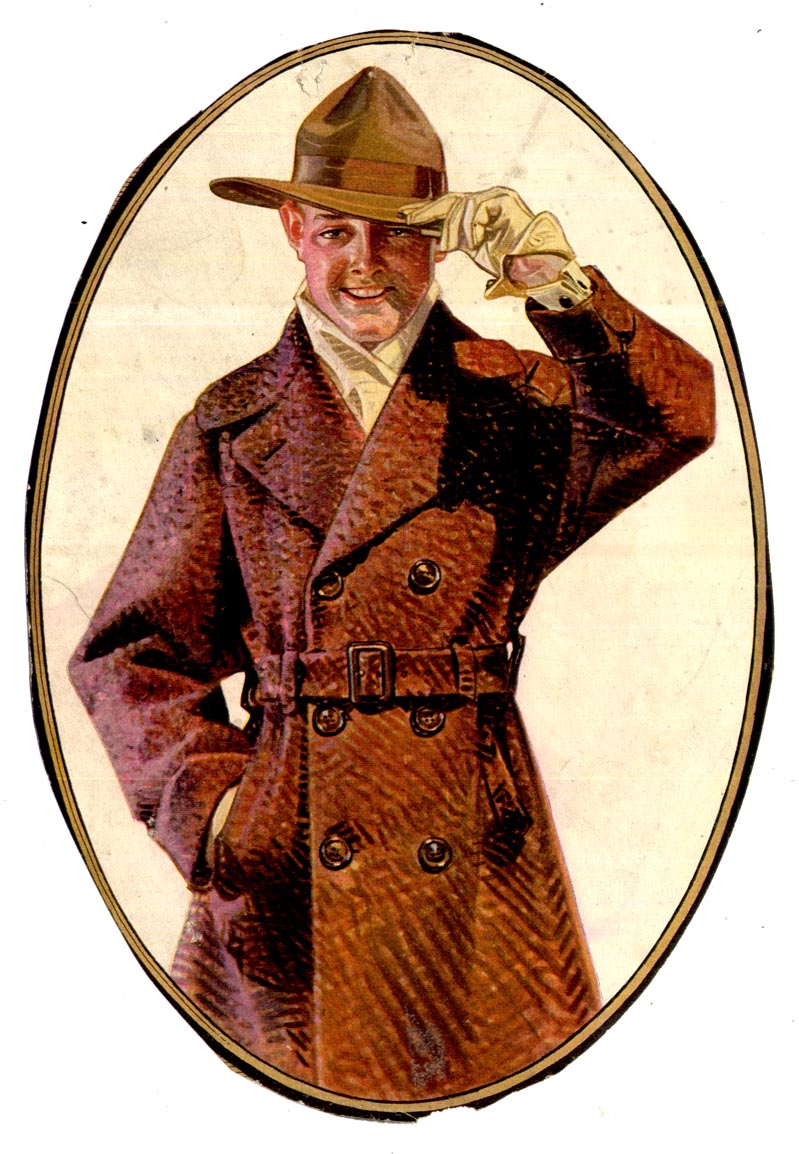
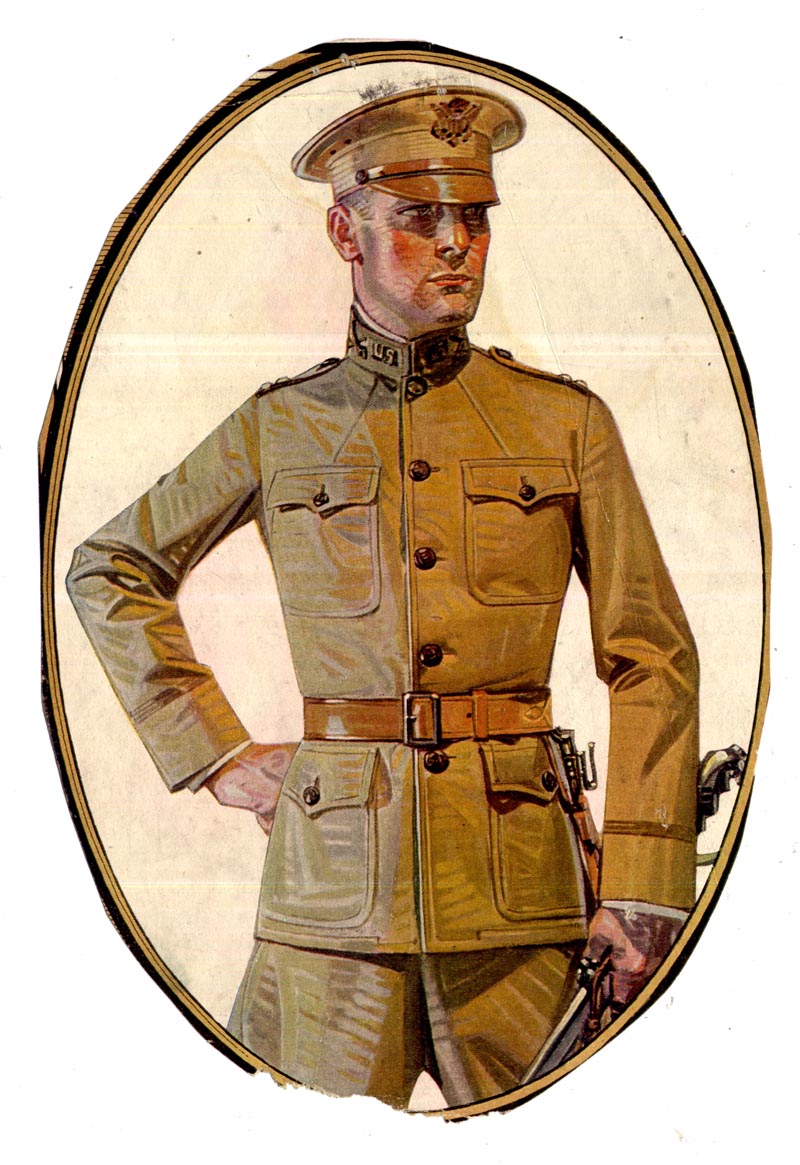
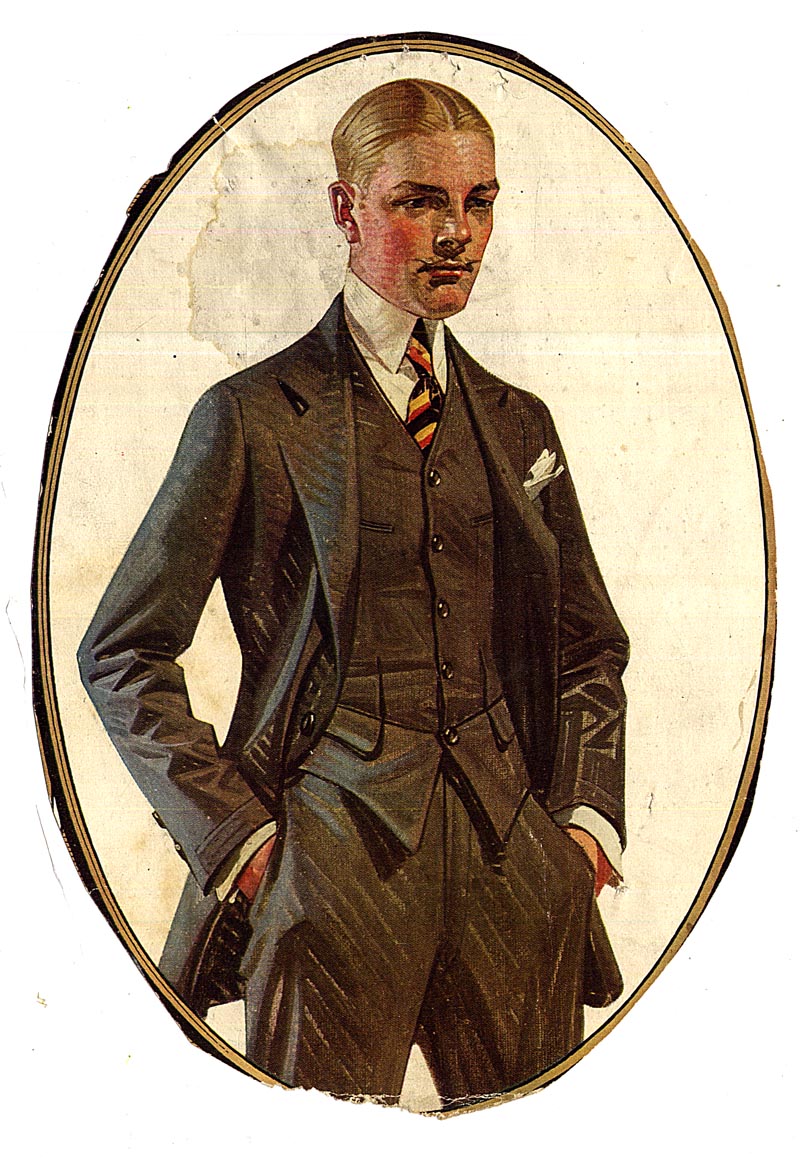
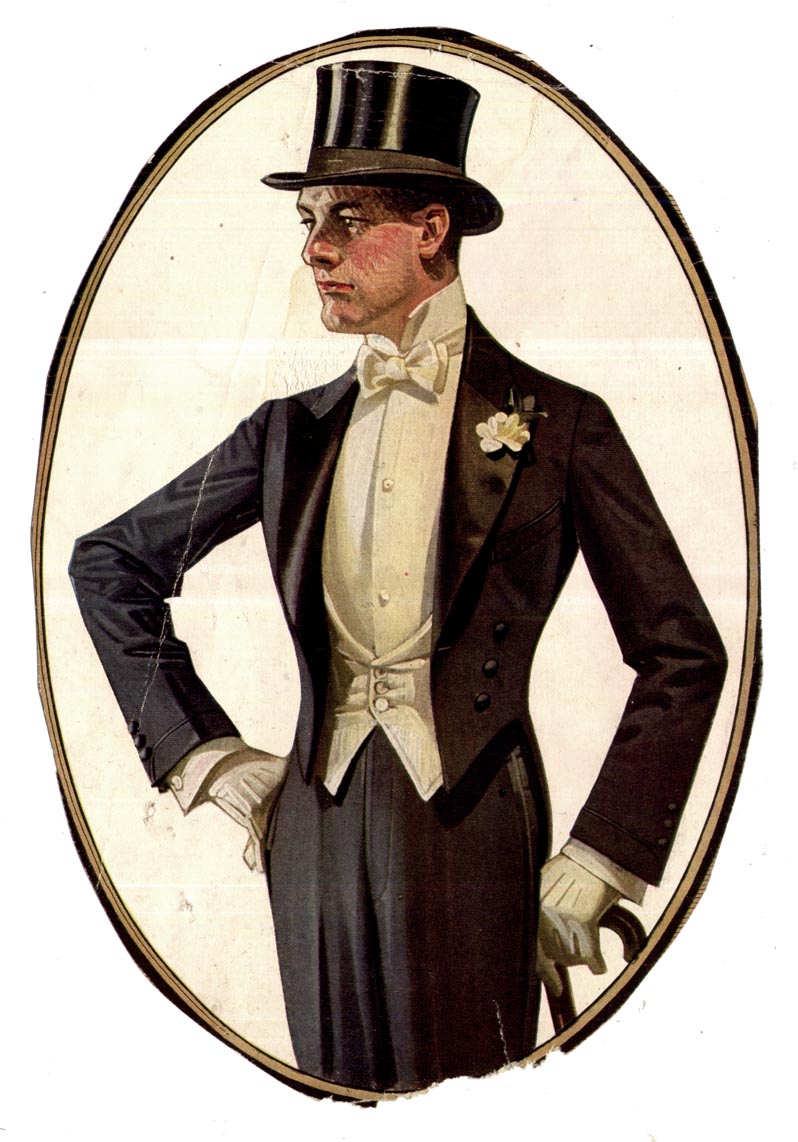
Kuppenheimer and Arrow, however, were top brands with big budgets, and they commissioned hundreds of advertising paintings from him.

He began the Kuppenheimer campaign with a parade of men in suits...
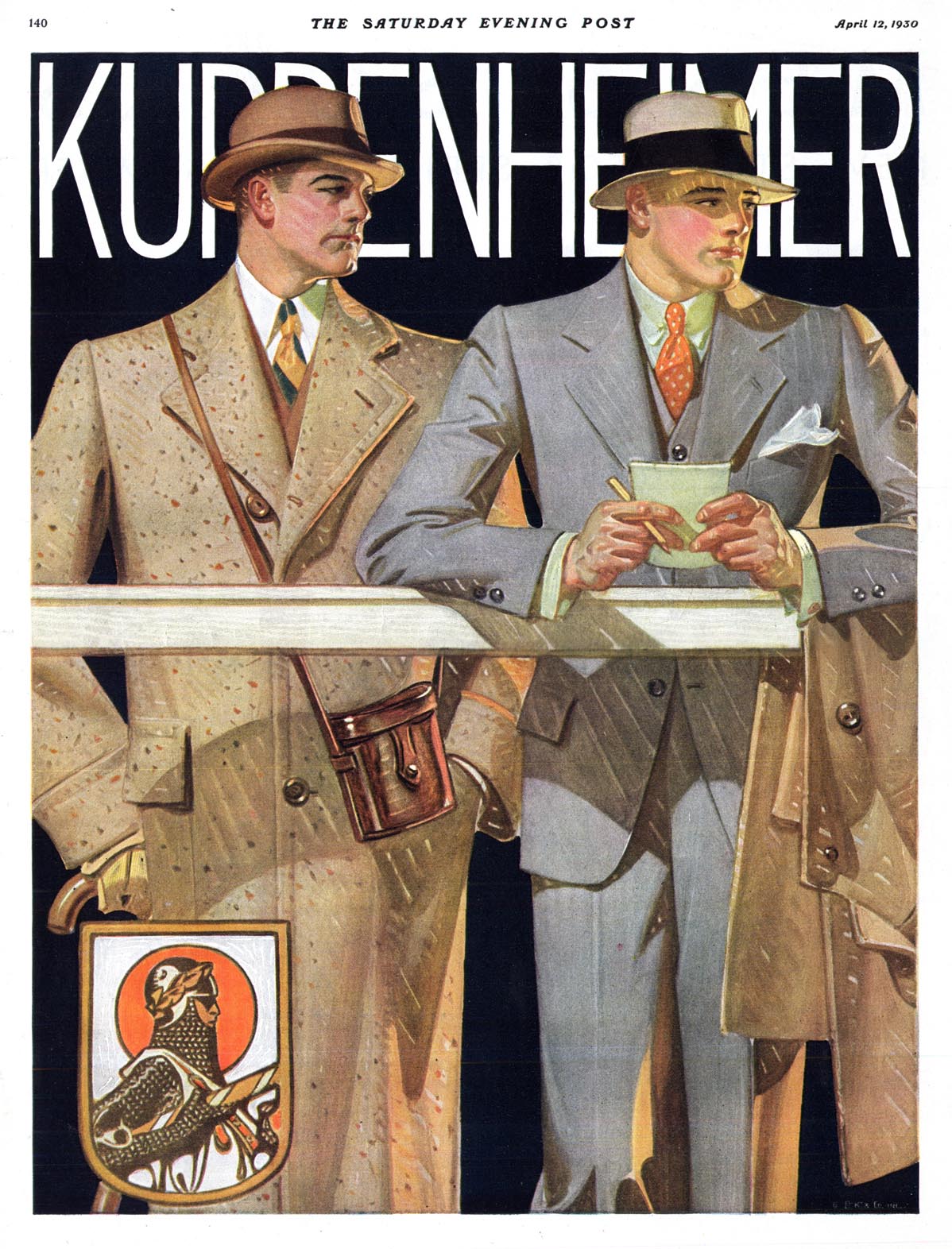
... but then began to incorporate the nice suits into plausible scenes of carefree young men, emphasizing collegiate sports.
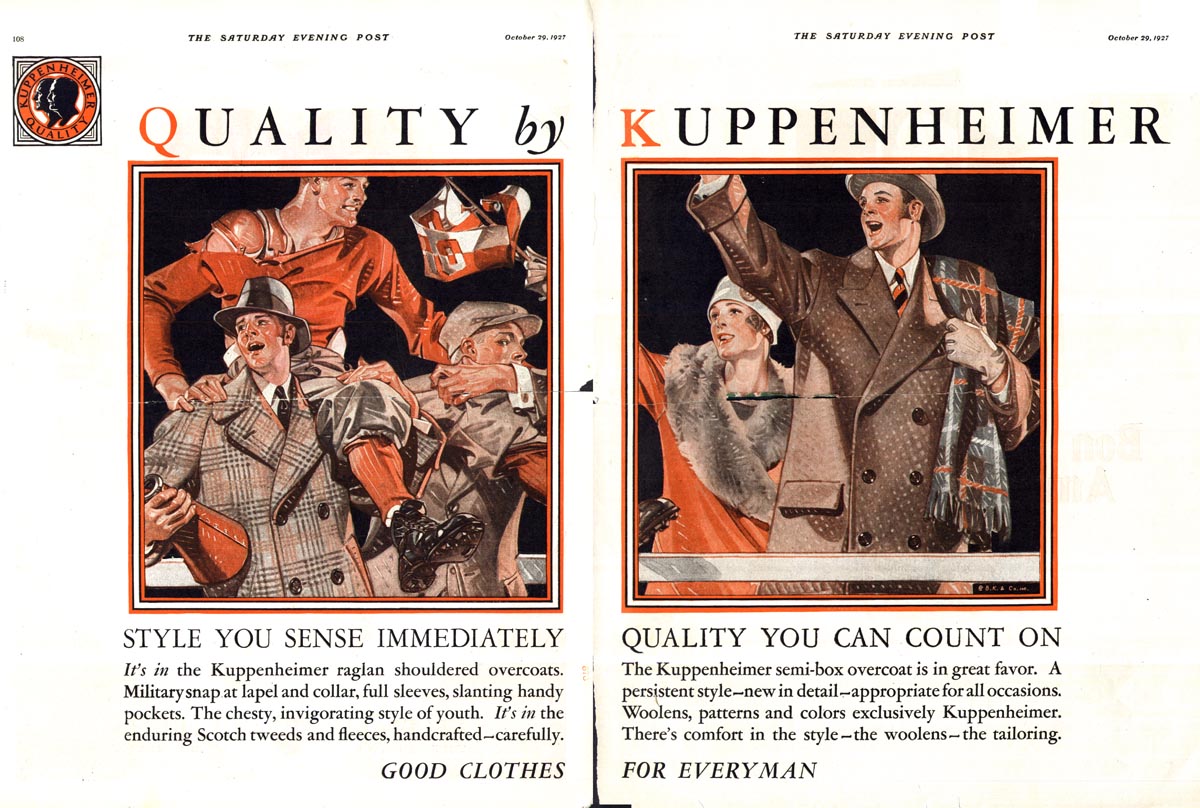
By evoking a youthful, virile atmosphere, J.C. built the foundation for today's advertising - the selling of lifestyle.
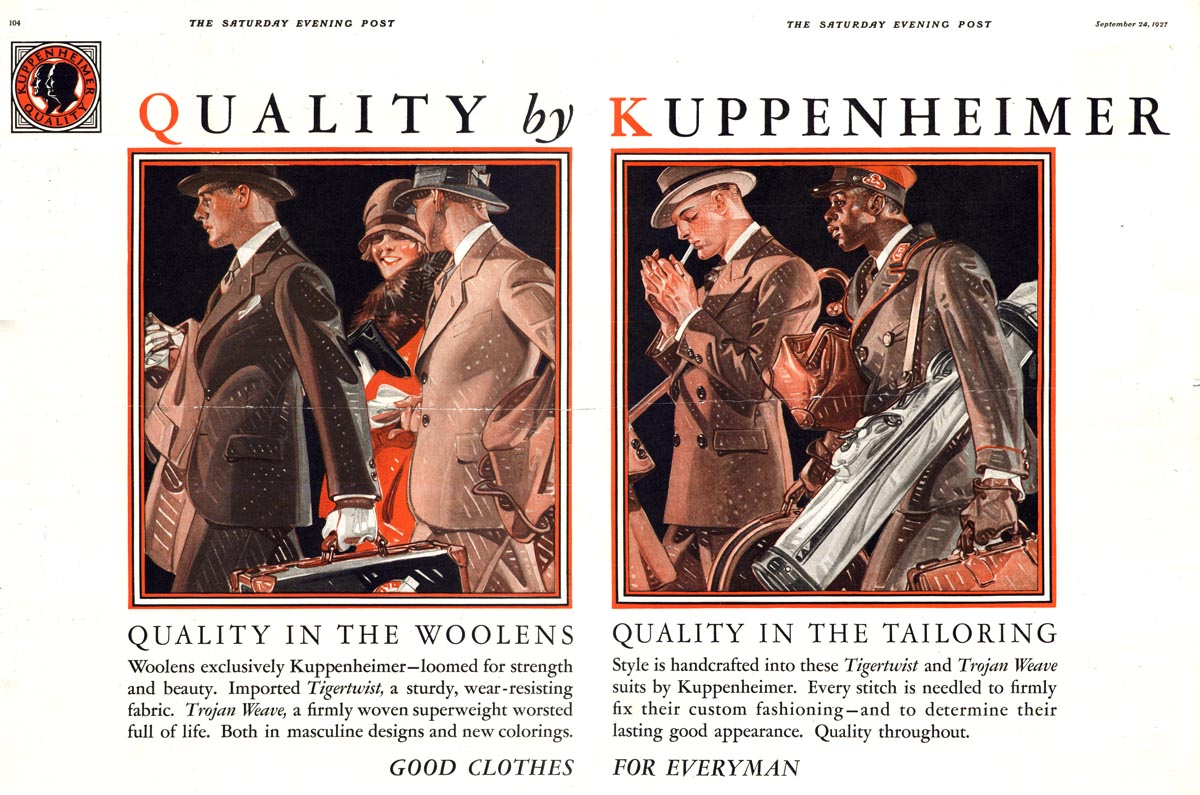
For Arrow, he forged a different identity, focusing not on the collars, but on the faces they framed.
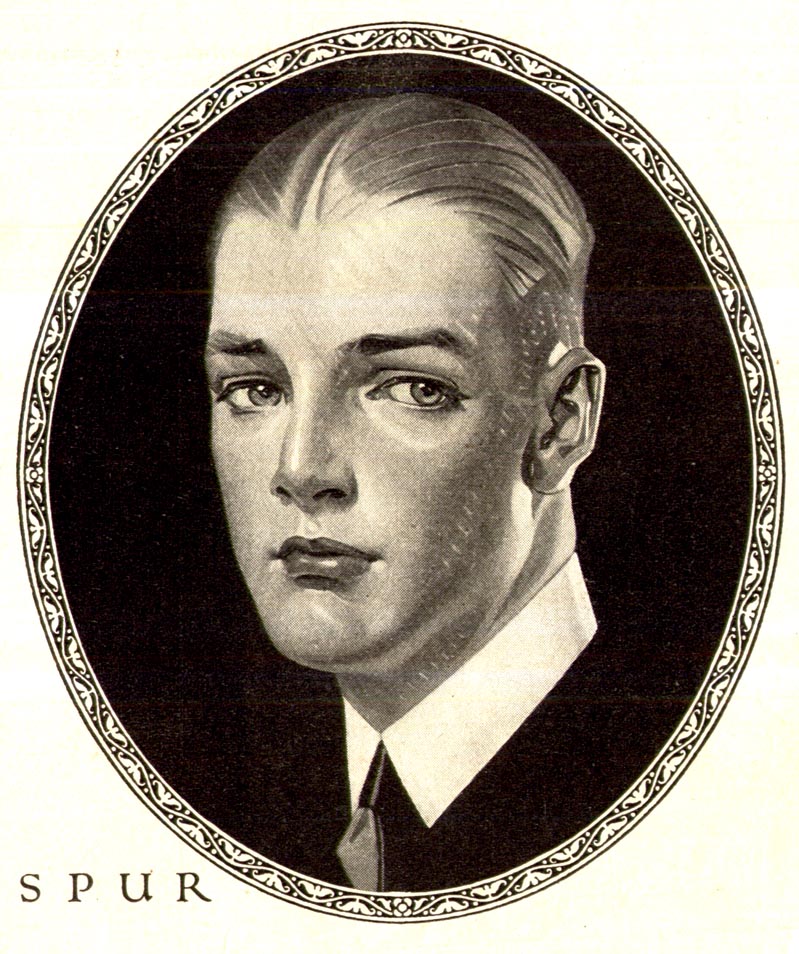
It was these mostly young, clean-shaven, preppy and patrician men that sold collars and inspired thousands of romantic inquiries from women that the Arrow Collar company suddenly found themselves fielding.
The Depression finally ended these campaigns...
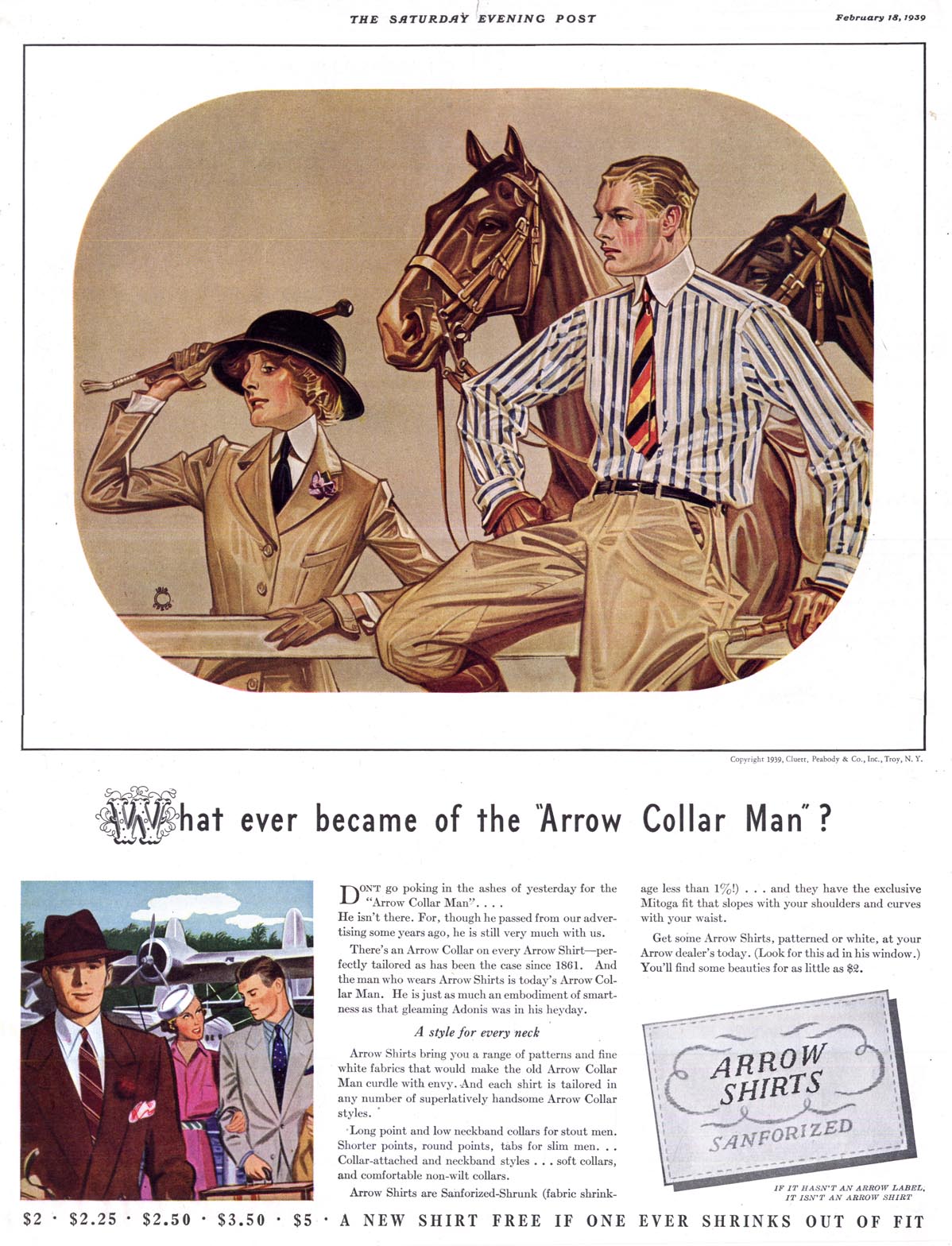
... but not before Leyendecker had produced his most stunning pictures: a series for Arrow with black backgrounds that are among the most elegant and seductive graphic designs in history.
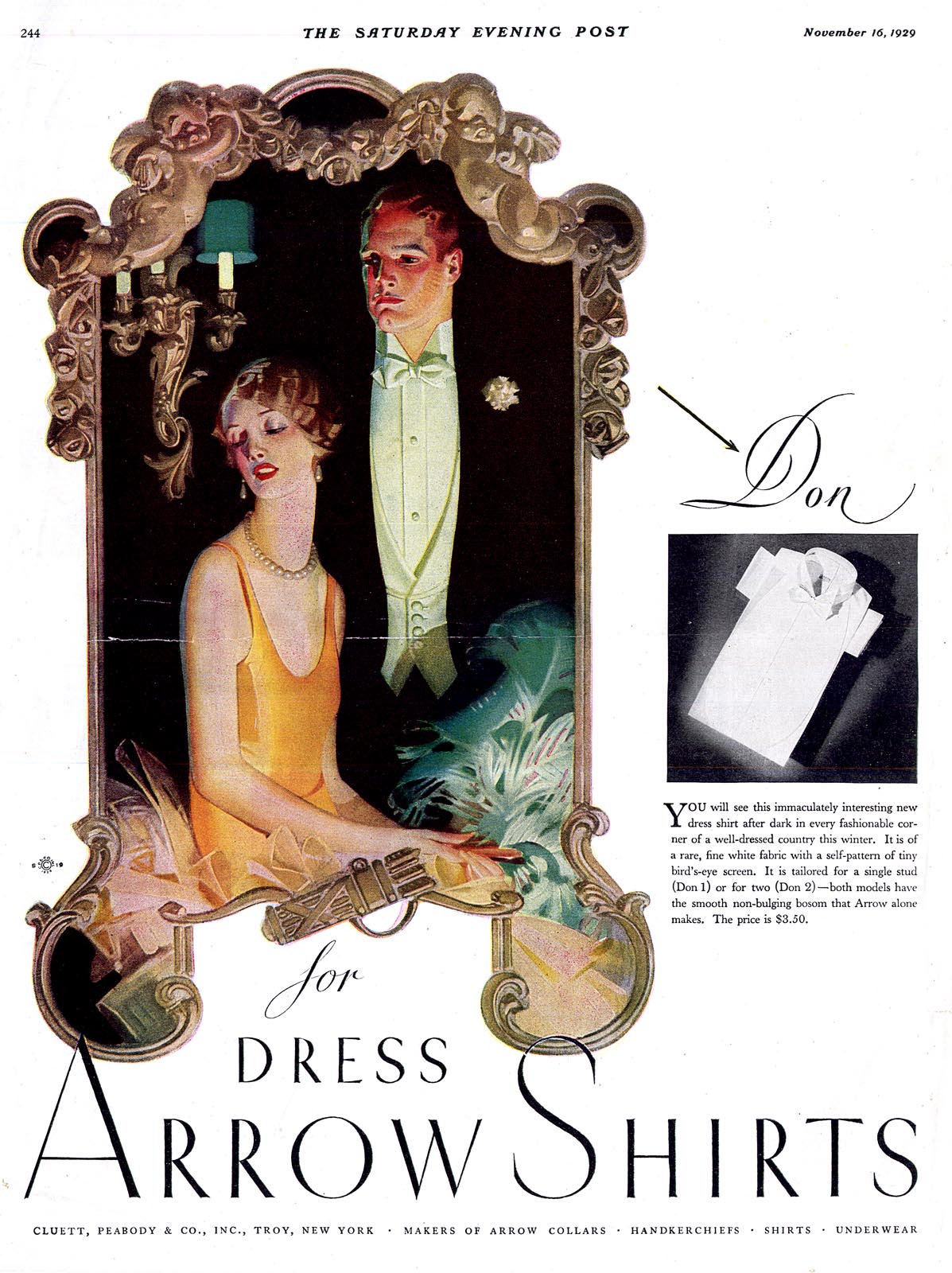
The most important Arrow man was Charles Beach, who was tall, handsome and as socially confident as J.C. was shy. Beach posed for dozens of paintings.
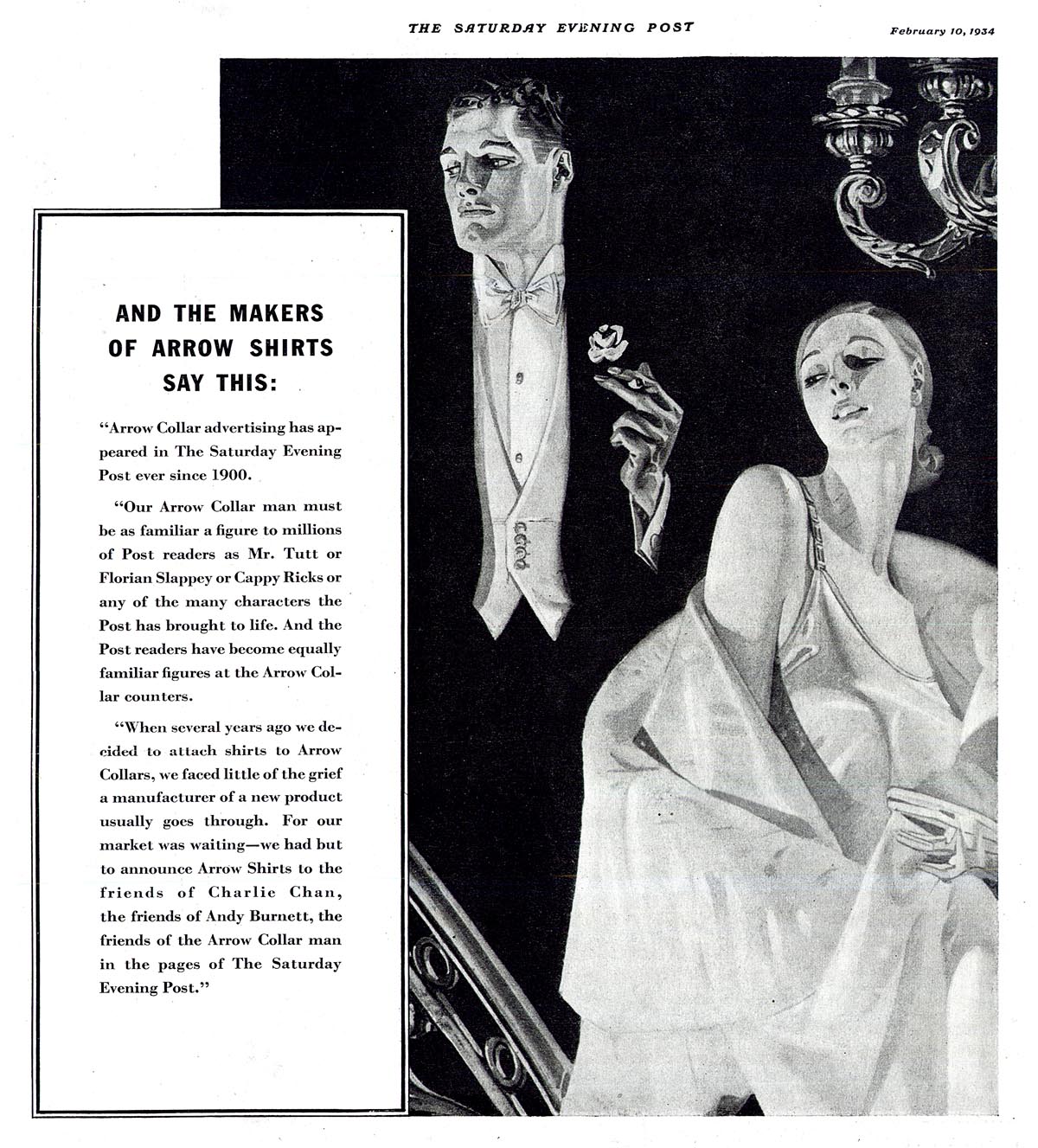
J.C. also needed a companion who could be his agent, publicist and manager and even his public face.

There is every indication that this relationship, which lasted from 1903 to the end of his life, freed him up to do the huge amount of work he accomplished.
* Concluded tomorrow.
* The text of today's post is excerpted from the brochure of the November '97 - May '98 J.C. Leyendecker Exhibit at the Norman Rockwell Museum and is © Roger T. Reed
Leif, it's great to see these Leyendecker images accompanied by Roger Reed's thoughtful text and Dr. Jennifer Greenhill's interesting ideas from the Rockwell center lecture. Like many others, I was dismayed by the scholarship and the themes of the recent Cutler book on Leyendecker, particularly its sensationalist efforts to manufacture a feud between Rockwell and Leyendecker. The great Leyendecker certainly deserved better, and I am glad to see TI helping him get his due.
ReplyDeleteThe Kuppenheimer and Arrow ads were the epitome of elegance, class and sophistication back then. The quality of a man's clothing and his manners, was the key to the quality of the man. Of course there were exceptions, but what a difference in today's society. Today, it seems to be more about personal comfort, convenience, entertainment and materialism. Not easy to visually depict that concept, with the exquisite taste of a Leyendecker painting.
ReplyDeleteIMO, Al Parker, Bernie Fuchs and Bob Peak were similar in stature to their peers as Leyendecker was to his piers. But, the public was much more aware of Leyendecker's illos, through the peak of their careers.
Tom Watson
Thanks David! :^)
ReplyDeleteTom; Based on the Leyendecker Bros. personal philosophy of living extravagantly beyond their means, I'd say it was as much about materialism back then as it is today.
ReplyDeleteWe already know how that philosophy contributed to the ruin of their relationship and no doubt Frank's untimely death.
As Roger Reed points out in his text; with these ads Leyendecker created the what became the basis of modern advertising: the selling of a lifestyle - not actually of clothing. And that lifestyle was a sham.
Fabulous... plenty of charm... great illustrators like these make us wonder about their time... thank you!
ReplyDeleteI must agree with those who point out that these wonderful images were the prototypes of today's "materialism." They sold the notion that one attains social stature by buying a certain suit. (Or alternately, that those who buy these suits are better than everyone else.) Today's ideals are different--the street-wise tough guy; the athletic, connected man of the world; the sexy business titan--but the method is exactly the same.
ReplyDeleteBecause I love the artwork so much I seldom dig too deeply into their underlying philosophy and thus, I suppose, I contribute to the effectiveness of this sort of propoganda.
On a technical note, I'm struck by the huge heads and scrawny bodies in the oval illustrations. Clearly this was art direction, not Leyendecker's personal style. J. C. seemed to prefer the traditional small-head-big-body idealization. He uses these proportions in the later Kuppenheimer ads. Wonder why the advertiser figured pipe-cleaner arms were classy.
It wasn't only the Depression that killed off the Arrow Collar Man. It was about that time that sewed-on collars became the standard, and the whole separate-collar industry went the way of the buggy-whip makers.
As to my taste, the clothes without content would be quite sufficient. I can do without some of those rather arrogant looking popinjays.
ReplyDeleteJust amazed by the way these tissues have been rendered; texture, pleats, lighting, subtlety of hues - just so much eye candy.
Also like the immaculate stylized layouts.
With the exception of David A. and Bishop, I can't say I agree with most of the comments here.. "that lifestyle was a sham". (?) "the sexy business titan" (?) "the prototypes of today's "materialism." (?) "those rather arrogant looking popinjays." (?)
ReplyDeleteThey were selling quality, not arrogance or an artificial lifestyle that has been implied by some comments. At the time, the public didn't look at these ads the way people do today. The demonization of wealth, Hollywood movies and journalists have distorted, stereotyped and propagandized the society and the eras of the past.. so the jaded comments aren't surprising to me.
Regardless, these illustrations are of a very high quality in concept, rendering skills and design.. and I think the clothing was great! They were targeting those that could afford the top of the line men's suites and dress shirts, and Leyendecker did it with style and flair.
Incidentally, in regards to "materialism," there were no credit cards then, most people could only buy what they could pay for. Today, if we want it we charge it, and then whine and bitch because we're in debt.. and blame the banks for issuing the credit card. I don't see the parallel between then and now.
Tom Watson
This type of product has always been advertised using 'snob' appeal,it's easier for advertisers to sell a dream of superiority than demonstrate how the product may or may not be more effective than its competitor.
ReplyDeleteRemo,
ReplyDeleteThe only snob appeal in those ads, would come from those that think snobbery is wearing a high quality, well tailored suit or dress shirt, looking clean cut and well groomed, instead of looking like a hung over slob with a three day stubble on his face and clothes that appear he slept in them for a week or two. But, I guess each of us sees these ads through our own sense of taste and level of sophistication. Those that could afford and preferred Kuppenheimer suites, didn't need snob appeal to persuade them to buy that brand. However, the ad men and Leyendecker knew the type of model that high society could relate to. If you read the copy, it also talks about the quality, workmanship and the style of the clothes. They're not selling tractors or shovels, so it doesn't take a rocket scientist to know why they would want to show their product displayed on a person of good taste, and not a mannequin or floating. If those Leyendecker ads are "snob appeal", then I take pleasure in calling myself a snob. ;-)
Tom Watson
P.S. I'm surprised the phallic symbol watchdogs haven't weighed in these ads. They must be asleep at the wheel. :-)
ReplyDeleteTom Watson
Tom, that card argument sounds quite credible:
ReplyDeleteYes, no creditcards around in those times - wherever these guys may have derived their wealth from, affording the Kuppenheimer apparel: that's open for conjecture, of course.
How about wealth accumulated from plundered colonies? Those were the times..:-) It must be just my stereotyped propagandized distorted view of the past, but some of these chaps in the gorgeous gallery here look like epitomes of colonial masters to me.
They may not have been employing slaves in their households. But there's that burdened "caddie-negro" depicted on the Saturday Evening cover (see Leif's 11th April post). Doesn't the illustration have a certain appeal?
Anyway, some strange white collar guys in fine clothes IMO. We're talking about the ad-world, of course, depicting the dreams of a large segment of corresponding societies, the majority's mainstream desires.
Minorities?
Looking at Norman Rockwell's famous & fabulous Thanksgiving turkey: A single vegetarian in the room would have spoilt it all;-)
Invariably these ads are directed to the people just under 'high society',so in that sense they're aspirational.
ReplyDeleteTruly wealthy people could afford to have their clothes tailor-made of a quality that didn't need this type of salesmanship.
It's similar to the Bruce Weber Abercrombie and Fitch ads,the dream of buying into a glamorous lifestyle by looking the part.
Are you suggesting lower middle class office workers couldn't look clean and smart in department store suits? It's my belief that people were a lot more diligent about 'keeping up appearences' than we are now, so to say they resembled "a hung over slob with a three day stubble on his face and clothes that appear he slept in them for a week or two." does them an injustice.
So, yes, its the snob appeal of having something better than the next man that might gain you entry into a new milieu that underlies this advertising.
Rich,
ReplyDeleteI could't have said it better. Those decadent rich fat cats (with the pipe cleaner arms and big heads) exploiting the second world countries so they can wear those expensive threads, while a black man shleps their luggage, so they don't soil their hands and perspire in their over priced suites, or muss up their slicked back pompadours.. while the average "Joe the plumber" can't afford the suite or the luxury of traveling abroad. Why? Because he didn't accumulate wealth off the backs of the impoverished. Maybe the government should have stepped in and forbidden ads like that, as insensitive and sending the wrong message to mainstream society. Well, if not pass a law and make it illegal, at least fine the bastards that approved and produced these retched ads, and maybe Leyendecker too.. and give that money to a local charity or even to a plundered colony. Hey Rich, I think we might be on to something big here. ;-)
Remo,
Your quote: "It's my belief that people were a lot more diligent about 'keeping up appearences' than we are now," Yep, they sure were Remo. Calvin Klein is a good example of projecting an image of sex appeal, etc., in their ads. I happen to like most Calvin Klein men's clothing, but I don't really like their ads. Even if I were younger and single, I wouldn't buy Calvin Klein clothes because I thought it would make me look sexy and attract the chicks. But, many of their clothing appeal to my taste, they fit well, look good and are comfortable. However, I don't wear Calvin Klein underwear, so I probably won't be asked to model their clothing after all. ;-) The point being that not everybody is vulnerable to the theory that consumers think if they buy a a garment that is draped on a sexy model, they will be sexy too., Even if the headline or body copy says so. I mean, lets give "joe the plumber," John Q. Public and Jane Q. Public a little credit for not being total fools.
Tom Watson
P.S. Pssst, if you want to indulge in a little hanky-panky at a cocktail party, ask the half naked nymph for a White Rock soda.. over the rocks! But, if you are married, don't let your wife catch you. ;-)
For God's sake, Tom, let's leave the government out here with it's fines and punishments.
ReplyDeleteThat would be as absurd as punishing the mirror for the reflections it throws at us.
Because a faithful mirror of society advertisements are, I would say.
So we better leave the messenger unhurt...
We're hardly on something big here; just average stuff.
The only big thing, from which we're tending to deviate in our present discussion, is the magnificent artistry, the fabulous skill, the hard work with its wonderful results we owe to Leyendecker & Co.
P.S: As to the present barrage of advertisements I'm experiencing - it has finally succeeded and left me with some deep philosophical insight:
"Cogito ergo sum"
which translates into
"I shop, therefore I am";-)
I have to tend to agree with Tom here. While the figures are a bit fussy and dandified (or as well expressed elsewhere: "arrogant looking popinjays") for my liking (I prefere the nostalgic mythos of Rockwell, though I'm not a big fan of his work, either), Leyedeckers images are high concept art and fantastically rendered. Where I agree with Tom is that that the materialism is not objectional, even where its not a materialism that we like or approve of. Here, the figures are "yuppie scum" of the 20's -- and therefore somewhat repugnant to some current sensibilities. Do I care that there are somewhat repugnant to me? No. No more than I care about the "high concept" ads of Calvin Klein's stuff. The issue of materialism never disappears in high concept illustration -- but the proof of the value of materialism is none other than the "little black dress." Any man that has ever seen, wooed, dated, or made love to a beautiful woman that can wear well the "little black dress" knows what I'm talking about -- its a material object that so well fits and enhances that beauty of some women that the real exceeds the ideal. So disparage materialism at your peril, as some materialism indeed enhances naturalism . . . Maybe arrow shirts did the same for the aspiring middle class dandy of the 20's ...
ReplyDeleteAsk yourself this: how much do these figures look like primates? Not much. Why not? Because material objects and ideals make the human primate rise above their hairy beastly reality (we are, after all genetically 98% chimpanzee). The "little black dress" proves that some ape girls are sexy angels. ;^)
Cheers!
Wes
Materialism can be quite charming and attractive!
ReplyDeleteAfter succeeding in provoking Tom into another elaborate statement, wow, this is another fine reading, Wes:-)
... "we are, after all genetically 98% chimpanzee". Is that Wes speaking or Darwin?
ReplyDeleteOh, I forgot to mention that Leyendecker was an amazing illustrator. His lighting effects, his color nuances and his rendering skills were masterful. I knew an old time Saturday Evening Post illustrator name Mike Dolas, that had a bunch of Leyendecker's originals and studies that he loved to show me.. and I loved to look at them. He said Leyendecker would do many many variations and details of hands, feet and expressions, before he would settle on one version. By that time, he had worked out all the drawing, design and rendering issues to the point of perfection. Then it was just a matter of time and manual labor to do the finish. It was a done deal before he stretched the canvas for the finished painting. His brush strokes were nearly computer accurate, and his spontaneity was as calculated as applying ink for a four color process magazine reproduction. Everything fit together like a precision puzzle.. concept, layout, design, props, models, drapery, gestures, facial expressions, lighting, color, form, etc. Some feel that this approach is not creative or subjective, but I disagree. The end result cannot be duplicated with photography and requires choices, personal taste and highly developed skills.. even though it is in the traditional realistic category.
Tom Watson
Tom Watson wrote, "Oh, I forgot to mention that Leyendecker was an amazing illustrator."
ReplyDeleteThanks, Tom-- I was hoping that somebody would eventually come back to the whole point of this post. Whatever was happening around him in terms of sociology, politics, culture or fashion, Leyendecker was a giant talent and the quality of his images rises above these lesser concerns, in my view.
By the way, if we want to focus on something really important, does anyone know what the "T" stands for in Roger T. Reed?